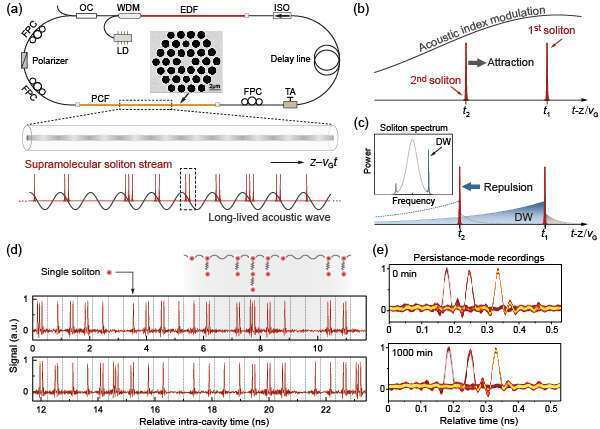
Supramolecular Assembly of Optical Solitons in a PCF-based Optoacoustically Mode-locked Fibre Laser
Intense optoacoustic interactions in a PCF-based mode-locked fibre laser enable long-range, non-covalent binding of optical solitons, leading to supramolecular assembly of solitons that exhibit long-term stability, structural flexibility, elementary diversity and possibilities of information encoding.
Long-range interactions between optical pulses during transmission in optical fibre have generally been regarded as noise sources that cause gradual degradation of the information encoded in optical pulse sequences. Here we report that by tailoring long-range, non-covalent pulse-pulse interactions, a large number of optical solitons can robustly couple to each other and self-assemble into stable supramolecular structures with built-in hierarchy [1]. Such structures exhibit several remarkable features, including long-term stability, structural flexibility, elementary diversity and the possibility of information encoding.
The experimental platform we employ is an fibre laser optoacoustically mode-locked by a solid-core photonic crystal fibre (PCF) [2], as sketched in Fig.1(a). The supramolecular soliton sequence generated in this laser coherently drives a long-lived acoustic wave in the PCF core which acts back on the soliton sequence, forming a “temporal optomechanical lattice” [2]. Within each time-slot of this lattice, multiple solitons can be stably bound with inter-pulse spacing 100 times longer than the individual pulse duration. This long-range binding originates from the balance between attractive and repulsive inter-soliton forces [3]. While the force of attraction results from optoacoustic interactions (see Fig.1(b)), the competing force of repulsion results from nonlinear perturbations by dispersive waves shed by the solitons (see Fig.1(c)). As a consequence, long-range bound states of two or three solitons can be stably trapped within different time-slots of the optomechanical lattice, forming supramolecularly-assembled soliton sequences. [1-3]
Two 11 ns long portions from a typical experimentally recorded supramolecular soliton sequence are shown in Fig.1(d). The exact pulse pattern was robustly preserved over several hours without degradation of the signal-to-noise ratio (see Fig.1(e)). Experimentally we observed that such assembled structures are highly malleable under continuous tuning of the long-range forces, and that conventional phase-locked soliton molecules [4] could be incorporated as building-blocks of the soliton supramolecules. Moreover, given stronger perturbations, individual solitons could be added into or removed from the pulse sequences without damaging their basic supramolecular structures, demonstrating the possibility of information encoding in such supramolecular soliton sequences.

Fig.1 (a). Sketch of the experimental set-up. (b) Attractive force arises between two solitons from the optoacoustic interactions. (c). Repulsive force arises due to dispersive wave (DW) perturbations (inset: soliton-laser spectrum). (d) Two 11 ns sections of a typical supramolecular soliton sequence. (e). Persistence-mode recordings at 0 min and 1000 min. No degradation of the signal-to-noise ratio was observed.
References
[1] W. He, et al, arXiv: 1710.01034 (2018)
[2] W. He, et al, arXiv: 1808.00824 (2018)
[3] M. Pang, et al, Nat. Photon. 10, 454 (2016)
[4] P. Grelu, et al, Nat. Photon. 6, 84 (2012)
Presenter Email: wenbin.he@mpl.mpg.de

Powered by Eventact EMS